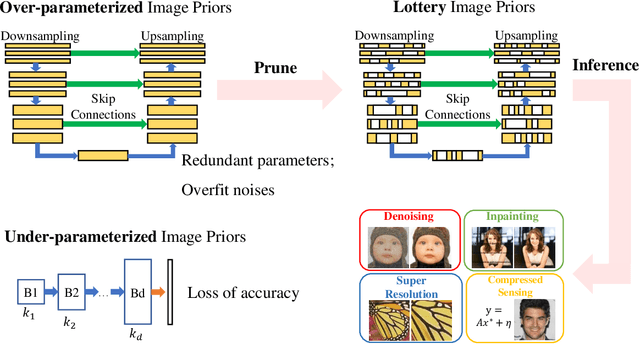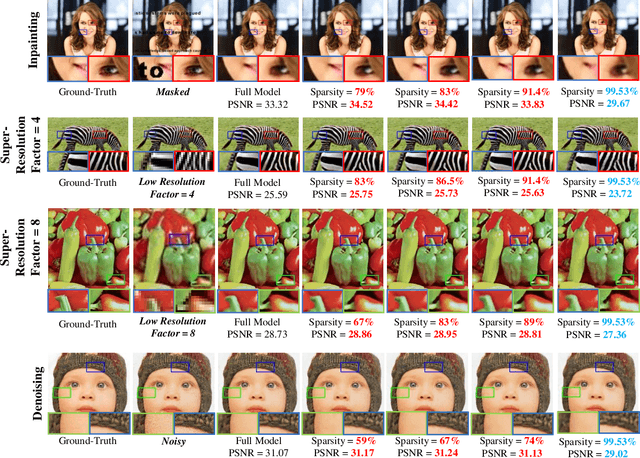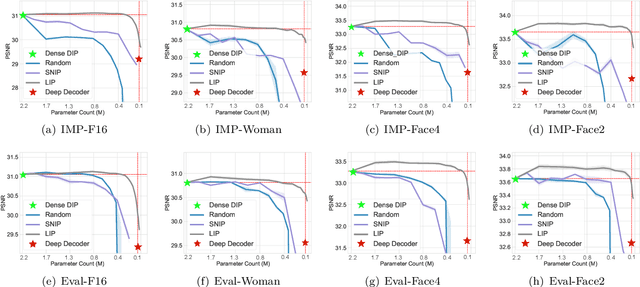Yifan Jiang
DiMeR: Disentangled Mesh Reconstruction Model
Apr 24, 2025Abstract:With the advent of large-scale 3D datasets, feed-forward 3D generative models, such as the Large Reconstruction Model (LRM), have gained significant attention and achieved remarkable success. However, we observe that RGB images often lead to conflicting training objectives and lack the necessary clarity for geometry reconstruction. In this paper, we revisit the inductive biases associated with mesh reconstruction and introduce DiMeR, a novel disentangled dual-stream feed-forward model for sparse-view mesh reconstruction. The key idea is to disentangle both the input and framework into geometry and texture parts, thereby reducing the training difficulty for each part according to the Principle of Occam's Razor. Given that normal maps are strictly consistent with geometry and accurately capture surface variations, we utilize normal maps as exclusive input for the geometry branch to reduce the complexity between the network's input and output. Moreover, we improve the mesh extraction algorithm to introduce 3D ground truth supervision. As for texture branch, we use RGB images as input to obtain the textured mesh. Overall, DiMeR demonstrates robust capabilities across various tasks, including sparse-view reconstruction, single-image-to-3D, and text-to-3D. Numerous experiments show that DiMeR significantly outperforms previous methods, achieving over 30% improvement in Chamfer Distance on the GSO and OmniObject3D dataset.
A Comprehensive Survey in LLM(-Agent) Full Stack Safety: Data, Training and Deployment
Apr 22, 2025Abstract:The remarkable success of Large Language Models (LLMs) has illuminated a promising pathway toward achieving Artificial General Intelligence for both academic and industrial communities, owing to their unprecedented performance across various applications. As LLMs continue to gain prominence in both research and commercial domains, their security and safety implications have become a growing concern, not only for researchers and corporations but also for every nation. Currently, existing surveys on LLM safety primarily focus on specific stages of the LLM lifecycle, e.g., deployment phase or fine-tuning phase, lacking a comprehensive understanding of the entire "lifechain" of LLMs. To address this gap, this paper introduces, for the first time, the concept of "full-stack" safety to systematically consider safety issues throughout the entire process of LLM training, deployment, and eventual commercialization. Compared to the off-the-shelf LLM safety surveys, our work demonstrates several distinctive advantages: (I) Comprehensive Perspective. We define the complete LLM lifecycle as encompassing data preparation, pre-training, post-training, deployment and final commercialization. To our knowledge, this represents the first safety survey to encompass the entire lifecycle of LLMs. (II) Extensive Literature Support. Our research is grounded in an exhaustive review of over 800+ papers, ensuring comprehensive coverage and systematic organization of security issues within a more holistic understanding. (III) Unique Insights. Through systematic literature analysis, we have developed reliable roadmaps and perspectives for each chapter. Our work identifies promising research directions, including safety in data generation, alignment techniques, model editing, and LLM-based agent systems. These insights provide valuable guidance for researchers pursuing future work in this field.
ACVUBench: Audio-Centric Video Understanding Benchmark
Mar 25, 2025Abstract:Audio often serves as an auxiliary modality in video understanding tasks of audio-visual large language models (LLMs), merely assisting in the comprehension of visual information. However, a thorough understanding of videos significantly depends on auditory information, as audio offers critical context, emotional cues, and semantic meaning that visual data alone often lacks. This paper proposes an audio-centric video understanding benchmark (ACVUBench) to evaluate the video comprehension capabilities of multimodal LLMs with a particular focus on auditory information. Specifically, ACVUBench incorporates 2,662 videos spanning 18 different domains with rich auditory information, together with over 13k high-quality human annotated or validated question-answer pairs. Moreover, ACVUBench introduces a suite of carefully designed audio-centric tasks, holistically testing the understanding of both audio content and audio-visual interactions in videos. A thorough evaluation across a diverse range of open-source and proprietary multimodal LLMs is performed, followed by the analyses of deficiencies in audio-visual LLMs. Demos are available at https://github.com/lark-png/ACVUBench.
Recent Advances in Large Langauge Model Benchmarks against Data Contamination: From Static to Dynamic Evaluation
Feb 23, 2025Abstract:Data contamination has received increasing attention in the era of large language models (LLMs) due to their reliance on vast Internet-derived training corpora. To mitigate the risk of potential data contamination, LLM benchmarking has undergone a transformation from static to dynamic benchmarking. In this work, we conduct an in-depth analysis of existing static to dynamic benchmarking methods aimed at reducing data contamination risks. We first examine methods that enhance static benchmarks and identify their inherent limitations. We then highlight a critical gap-the lack of standardized criteria for evaluating dynamic benchmarks. Based on this observation, we propose a series of optimal design principles for dynamic benchmarking and analyze the limitations of existing dynamic benchmarks. This survey provides a concise yet comprehensive overview of recent advancements in data contamination research, offering valuable insights and a clear guide for future research efforts. We maintain a GitHub repository to continuously collect both static and dynamic benchmarking methods for LLMs. The repository can be found at this link.
Lung-DDPM: Semantic Layout-guided Diffusion Models for Thoracic CT Image Synthesis
Feb 21, 2025Abstract:With the rapid development of artificial intelligence (AI), AI-assisted medical imaging analysis demonstrates remarkable performance in early lung cancer screening. However, the costly annotation process and privacy concerns limit the construction of large-scale medical datasets, hampering the further application of AI in healthcare. To address the data scarcity in lung cancer screening, we propose Lung-DDPM, a thoracic CT image synthesis approach that effectively generates high-fidelity 3D synthetic CT images, which prove helpful in downstream lung nodule segmentation tasks. Our method is based on semantic layout-guided denoising diffusion probabilistic models (DDPM), enabling anatomically reasonable, seamless, and consistent sample generation even from incomplete semantic layouts. Our results suggest that the proposed method outperforms other state-of-the-art (SOTA) generative models in image quality evaluation and downstream lung nodule segmentation tasks. Specifically, Lung-DDPM achieved superior performance on our large validation cohort, with a Fr\'echet inception distance (FID) of 0.0047, maximum mean discrepancy (MMD) of 0.0070, and mean squared error (MSE) of 0.0024. These results were 7.4$\times$, 3.1$\times$, and 29.5$\times$ better than the second-best competitors, respectively. Furthermore, the lung nodule segmentation model, trained on a dataset combining real and Lung-DDPM-generated synthetic samples, attained a dice coefficient (Dice) of 0.3914 and sensitivity of 0.4393. This represents 8.8\% and 18.6\% improvements in DICE and sensitivity compared to the model trained solely on real samples. The experimental results highlight Lung-DDPM's potential for a broader range of medical imaging applications, such as general tumor segmentation, cancer survival estimation, and risk prediction.
Wasserstein distributional adversarial training for deep neural networks
Feb 13, 2025Abstract:Design of adversarial attacks for deep neural networks, as well as methods of adversarial training against them, are subject of intense research. In this paper, we propose methods to train against distributional attack threats, extending the TRADES method used for pointwise attacks. Our approach leverages recent contributions and relies on sensitivity analysis for Wasserstein distributionally robust optimization problems. We introduce an efficient fine-tuning method which can be deployed on a previously trained model. We test our methods on a range of pre-trained models on RobustBench. These experimental results demonstrate the additional training enhances Wasserstein distributional robustness, while maintaining original levels of pointwise robustness, even for already very successful networks. The improvements are less marked for models pre-trained using huge synthetic datasets of 20-100M images. However, remarkably, sometimes our methods are still able to improve their performance even when trained using only the original training dataset (50k images).
STIV: Scalable Text and Image Conditioned Video Generation
Dec 10, 2024Abstract:The field of video generation has made remarkable advancements, yet there remains a pressing need for a clear, systematic recipe that can guide the development of robust and scalable models. In this work, we present a comprehensive study that systematically explores the interplay of model architectures, training recipes, and data curation strategies, culminating in a simple and scalable text-image-conditioned video generation method, named STIV. Our framework integrates image condition into a Diffusion Transformer (DiT) through frame replacement, while incorporating text conditioning via a joint image-text conditional classifier-free guidance. This design enables STIV to perform both text-to-video (T2V) and text-image-to-video (TI2V) tasks simultaneously. Additionally, STIV can be easily extended to various applications, such as video prediction, frame interpolation, multi-view generation, and long video generation, etc. With comprehensive ablation studies on T2I, T2V, and TI2V, STIV demonstrate strong performance, despite its simple design. An 8.7B model with 512 resolution achieves 83.1 on VBench T2V, surpassing both leading open and closed-source models like CogVideoX-5B, Pika, Kling, and Gen-3. The same-sized model also achieves a state-of-the-art result of 90.1 on VBench I2V task at 512 resolution. By providing a transparent and extensible recipe for building cutting-edge video generation models, we aim to empower future research and accelerate progress toward more versatile and reliable video generation solutions.
Chasing Better Deep Image Priors between Over- and Under-parameterization
Oct 31, 2024



Abstract:Deep Neural Networks (DNNs) are well-known to act as over-parameterized deep image priors (DIP) that regularize various image inverse problems. Meanwhile, researchers also proposed extremely compact, under-parameterized image priors (e.g., deep decoder) that are strikingly competent for image restoration too, despite a loss of accuracy. These two extremes push us to think whether there exists a better solution in the middle: between over- and under-parameterized image priors, can one identify "intermediate" parameterized image priors that achieve better trade-offs between performance, efficiency, and even preserving strong transferability? Drawing inspirations from the lottery ticket hypothesis (LTH), we conjecture and study a novel "lottery image prior" (LIP) by exploiting DNN inherent sparsity, stated as: given an over-parameterized DNN-based image prior, it will contain a sparse subnetwork that can be trained in isolation, to match the original DNN's performance when being applied as a prior to various image inverse problems. Our results validate the superiority of LIPs: we can successfully locate the LIP subnetworks from over-parameterized DIPs at substantial sparsity ranges. Those LIP subnetworks significantly outperform deep decoders under comparably compact model sizes (by often fully preserving the effectiveness of their over-parameterized counterparts), and they also possess high transferability across different images as well as restoration task types. Besides, we also extend LIP to compressive sensing image reconstruction, where a pre-trained GAN generator is used as the prior (in contrast to untrained DIP or deep decoder), and confirm its validity in this setting too. To our best knowledge, this is the first time that LTH is demonstrated to be relevant in the context of inverse problems or image priors.
* Codes are available at https://github.com/VITA-Group/Chasing-Better-DIPs
Cavia: Camera-controllable Multi-view Video Diffusion with View-Integrated Attention
Oct 14, 2024Abstract:In recent years there have been remarkable breakthroughs in image-to-video generation. However, the 3D consistency and camera controllability of generated frames have remained unsolved. Recent studies have attempted to incorporate camera control into the generation process, but their results are often limited to simple trajectories or lack the ability to generate consistent videos from multiple distinct camera paths for the same scene. To address these limitations, we introduce Cavia, a novel framework for camera-controllable, multi-view video generation, capable of converting an input image into multiple spatiotemporally consistent videos. Our framework extends the spatial and temporal attention modules into view-integrated attention modules, improving both viewpoint and temporal consistency. This flexible design allows for joint training with diverse curated data sources, including scene-level static videos, object-level synthetic multi-view dynamic videos, and real-world monocular dynamic videos. To our best knowledge, Cavia is the first of its kind that allows the user to precisely specify camera motion while obtaining object motion. Extensive experiments demonstrate that Cavia surpasses state-of-the-art methods in terms of geometric consistency and perceptual quality. Project Page: https://ir1d.github.io/Cavia/
RED QUEEN: Safeguarding Large Language Models against Concealed Multi-Turn Jailbreaking
Sep 26, 2024



Abstract:The rapid progress of Large Language Models (LLMs) has opened up new opportunities across various domains and applications; yet it also presents challenges related to potential misuse. To mitigate such risks, red teaming has been employed as a proactive security measure to probe language models for harmful outputs via jailbreak attacks. However, current jailbreak attack approaches are single-turn with explicit malicious queries that do not fully capture the complexity of real-world interactions. In reality, users can engage in multi-turn interactions with LLM-based chat assistants, allowing them to conceal their true intentions in a more covert manner. To bridge this gap, we, first, propose a new jailbreak approach, RED QUEEN ATTACK. This method constructs a multi-turn scenario, concealing the malicious intent under the guise of preventing harm. We craft 40 scenarios that vary in turns and select 14 harmful categories to generate 56k multi-turn attack data points. We conduct comprehensive experiments on the RED QUEEN ATTACK with four representative LLM families of different sizes. Our experiments reveal that all LLMs are vulnerable to RED QUEEN ATTACK, reaching 87.62% attack success rate on GPT-4o and 75.4% on Llama3-70B. Further analysis reveals that larger models are more susceptible to the RED QUEEN ATTACK, with multi-turn structures and concealment strategies contributing to its success. To prioritize safety, we introduce a straightforward mitigation strategy called RED QUEEN GUARD, which aligns LLMs to effectively counter adversarial attacks. This approach reduces the attack success rate to below 1% while maintaining the model's performance across standard benchmarks. Full implementation and dataset are publicly accessible at https://github.com/kriti-hippo/red_queen.
 Add to Chrome
Add to Chrome Add to Firefox
Add to Firefox Add to Edge
Add to Edge